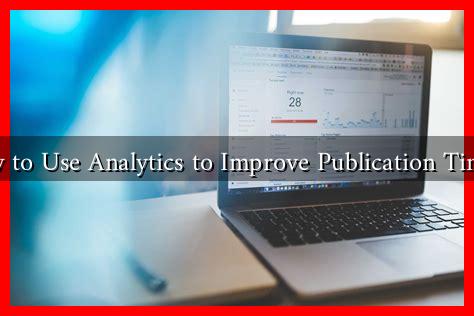-
Table of Contents
How to Use Analytics to Improve Publication Timing
In the fast-paced world of digital content, timing can be everything. Whether you’re a blogger, a marketer, or a publisher, understanding when to release your content can significantly impact its reach and engagement. By leveraging analytics, you can make data-driven decisions that enhance your publication timing. This article explores how to use analytics effectively to optimize your content release schedule.
The Importance of Publication Timing
Publication timing is crucial for maximizing audience engagement and ensuring that your content reaches the right people at the right time. Here are some reasons why timing matters:
- Increased Visibility: Content published at peak times is more likely to be seen and shared.
- Higher Engagement Rates: Posts released when your audience is most active tend to receive more comments, likes, and shares.
- Improved SEO Performance: Timely content can lead to higher search engine rankings, as search engines favor fresh and relevant material.
Utilizing Analytics Tools
To improve your publication timing, you need to harness the power of analytics tools. Here are some popular options:
- Google Analytics: This tool provides insights into user behavior, including when your audience is most active on your site.
- Social Media Analytics: Platforms like Facebook, Twitter, and Instagram offer analytics that show when your followers are online and engaging with your content.
- Content Management Systems (CMS): Many CMS platforms have built-in analytics that track post performance over time.
Analyzing Audience Behavior
Understanding your audience’s behavior is key to optimizing publication timing. Here are some strategies to analyze audience data:
- Identify Peak Traffic Times: Use Google Analytics to determine when your website experiences the highest traffic. Look for patterns over days, weeks, and months.
- Monitor Social Media Engagement: Check your social media analytics to find out when your posts receive the most engagement. This can help you identify the best times to share new content.
- Segment Your Audience: Different segments of your audience may have different peak times. Use demographic data to tailor your publication schedule accordingly.
Case Studies: Successful Timing Strategies
Several brands have successfully used analytics to improve their publication timing. Here are a couple of notable examples:
- BuzzFeed: By analyzing social media engagement, BuzzFeed discovered that their audience was most active during evenings and weekends. They adjusted their publication schedule accordingly, resulting in a 30% increase in shares.
- Buffer: Buffer used their own analytics to determine the best times to post on social media. They found that posts shared during weekdays, particularly on Wednesdays and Thursdays, received the most engagement. This insight helped them refine their content strategy.
Testing and Iterating Your Strategy
Once you have gathered data and made initial adjustments to your publication timing, it’s essential to test and iterate your strategy. Here’s how:
- A/B Testing: Experiment with different publication times for similar content to see which performs better.
- Regularly Review Analytics: Set a schedule to review your analytics regularly. This will help you stay updated on any changes in audience behavior.
- Stay Flexible: Be prepared to adjust your strategy based on new data or changes in your audience’s habits.
Conclusion
Using analytics to improve publication timing is a powerful strategy that can lead to increased visibility, engagement, and overall content performance. By leveraging tools like Google Analytics and social media insights, you can gain a deeper understanding of your audience’s behavior and preferences. Remember to test and iterate your strategies regularly to stay ahead of the curve. With the right approach, you can ensure that your content reaches its maximum potential.
For more insights on content strategy and analytics, consider visiting HubSpot’s Marketing Statistics.


